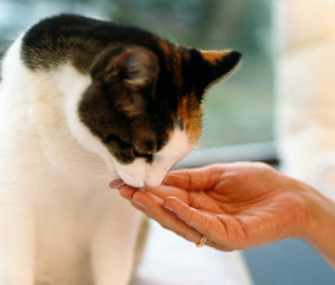Training Your Cat to Come When Called
Published on April 25, 2012

Teaching your cat to come when called is not only handy but could save his life. If he escapes outside, you can call him back home. You can also call him when inside the house to make sure he's accounted for before leaving the house, or to gather him up for a trip to the veterinarian.
If he's an indoor and outdoor cat, you can call him inside before you leave the house. You can call him to walk with you when your hands are full and the door is open. And you can just call him to you when you want to visit with him. Even if he's an outdoor cat, you can call him home if a storm or other danger is looming.
Teach Your Cat to Come on Command
Your cat probably already comes when called — only he comes to the call of the electric can opener or the ping of dry cat food hitting his bowl. It's just one step to go from that to coming to the call of your voice or to a whistle — whistles aren't just for dogs!
Just as the sound of a can opener signals good food is on its way, your come command should also signal that good food comes to those who come. You should teach him that when called, it's not just good food, but wonderful food. Experiment to see what your cat really likes — tuna, cat treats, sardines — and reserve it only for those times you've called.
Although you could just play a recording of the can opener, that would be inconvenient, so instead, decide how you will call your cat. Use something you don't otherwise say during the day. "Here, kitty, kitty, kitty" is a favorite, or you could use a whistle. Don't, however, simply use the cat's name. His name is just to get his attention; it should be followed by a cue to actually come. Everyone in the house should use the same way of calling.
A deaf cat can be trained to come to vibrations, such as thumping your foot on the floor, or to visual cues, such as a light flicking on and off.
How Food Can Aid in Training
If your cat already comes running to the sound of the can opener or the shaking of the treat bag, you can let that aid in training. Call your cat immediately before making the sound she already comes to. Your call must come before the sound — not at the same time or after — because in that way your call will quickly come to predict the other sound and food. Practice having your cat run to you in the kitchen, or wherever she usually eats, at first. Then go to other rooms and have her come to you there, feeding her as soon as she reaches you. Be sure to stroke and praise her as well. Once she's coming, don't take her training for granted. Whenever she comes, reward her. If you train her when she's already hungry, you'll make even faster progress. If your cat spends time outside, you can also call her to the house and reward her.
The Best Time to Train Your Kitten
The best time to teach your cat to come when called is when she's a young kitten, but no matter how old she is, she can still learn. Always make coming to you rewarding. Even if you've hunted and called for the past hour, only to see your cat finally meander out yawning from under the bed, grit your teeth and reward her. If you want your cat to come so you can cut her nails or give her medicine, go find her rather than call her. True, sometimes you have to call her for things that aren't on the top of her fun things to do list, but try to keep those to a minimum. One day your cat's life may depend on her coming to you without hesitation — don't give her reason to wonder if it's worth coming or not.





